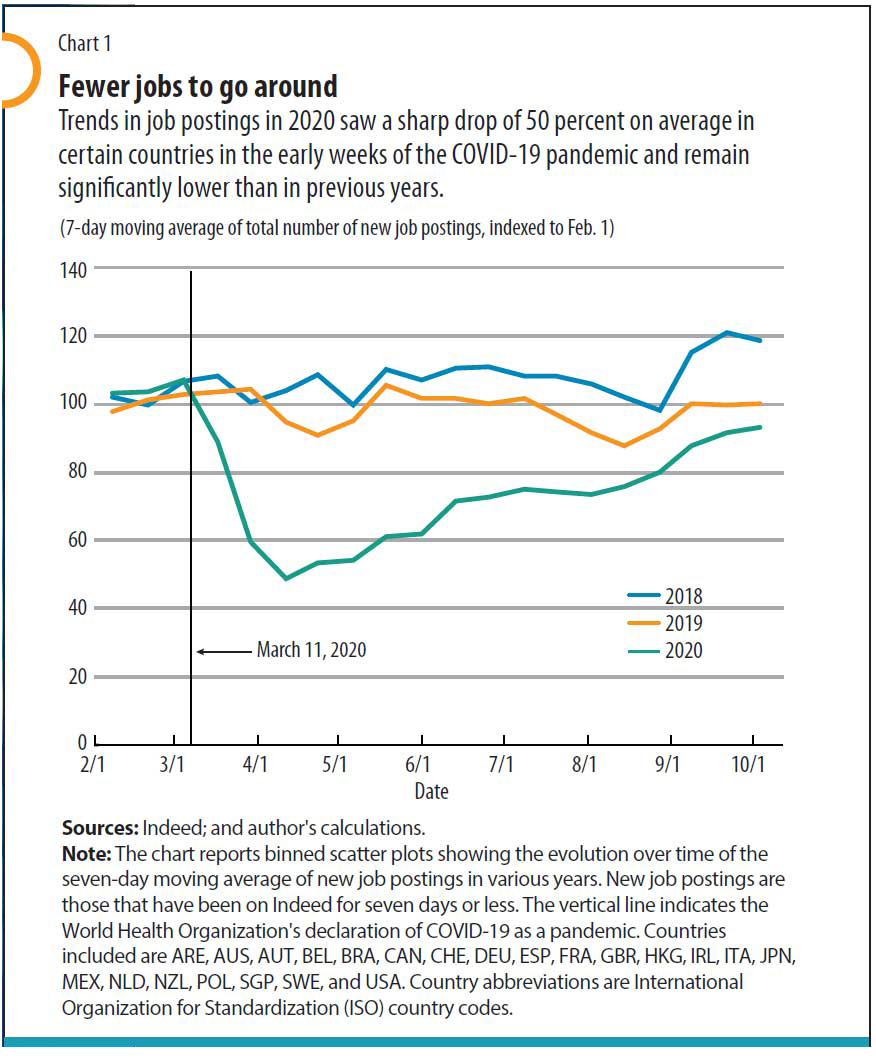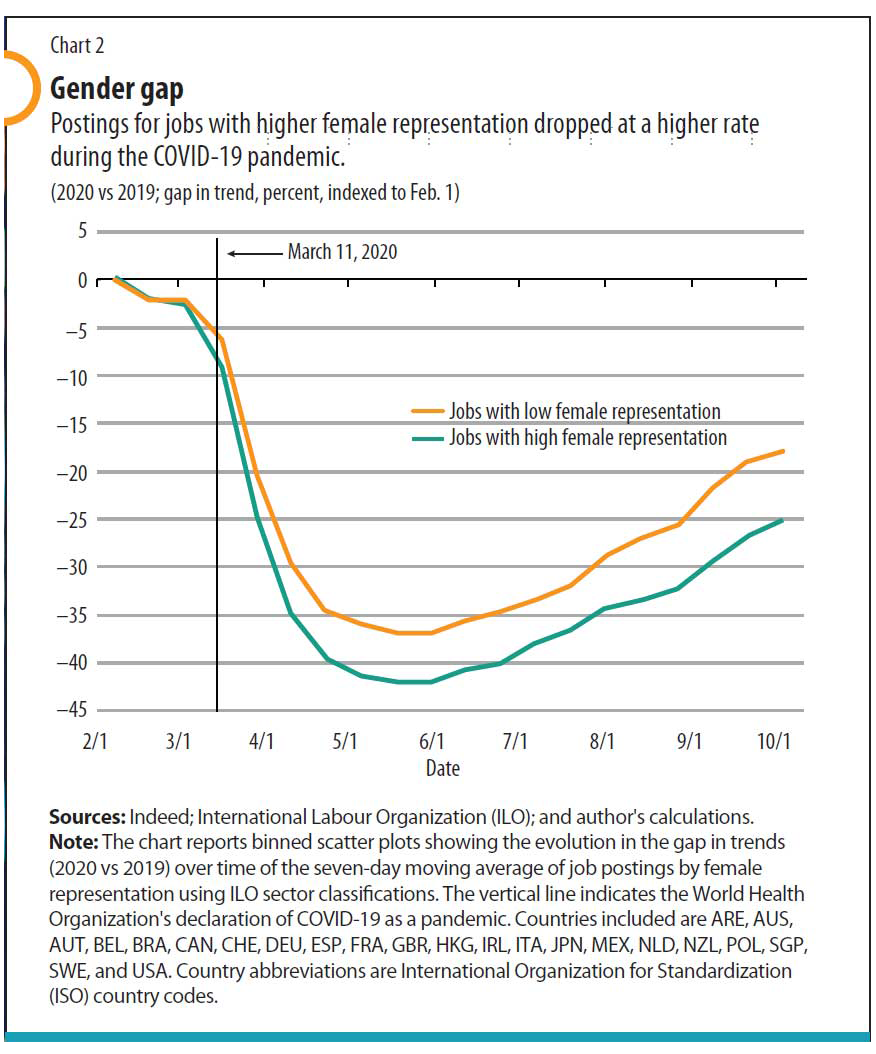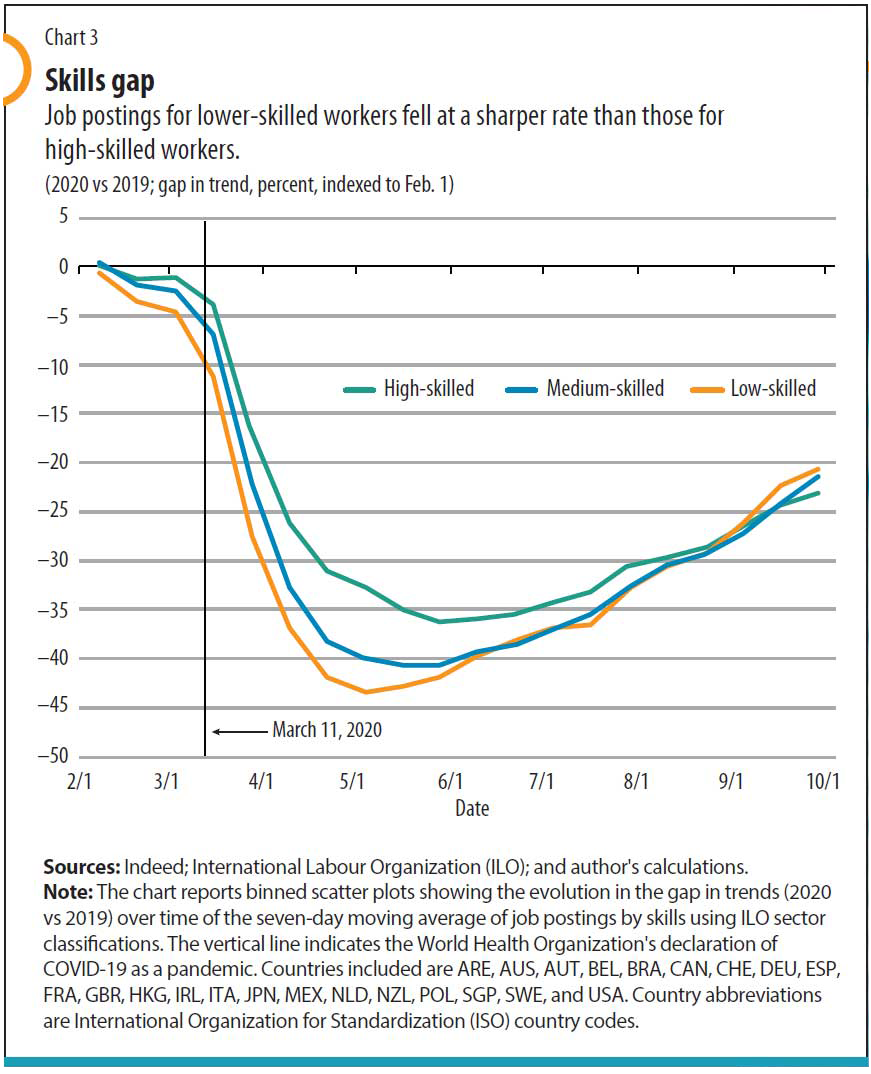Online job posting analysis shows the extent of the pandemic's damage, especially to women and youth
High-frequency data are critical when it comes to tracking the rapid economic destruction and disruption wrought by the COVID-19 pandemic. This information has also helped confirm, nearly in real time, the unequal impact of the crisis on particular populations, especially women.
Weekly and sometimes daily snapshots of human behavior—restaurant reservations, pedestrian traffic, mobile phone data, airport checkpoint volume, retail activity, and even nighttime images of Earth from space—are now closely scrutinized. Embedded within these high-frequency data are clues that may paint a picture of the impact of the crisis on the outlook for women, young people, and minorities and possibly foretell changes for years to come. The use of real-time data for decision-making was growing rapidly even before the pandemic, mostly because of progress in digitalization and the emergence of big data. The COVID-19 pandemic, however, has brought its usefulness into sharp relief.
The pandemic decimated the labor market at record speed. Official data reported on a quarterly or even monthly basis have struggled to keep pace with a wave of unemployment unseen since the Great Depression. Labor market data produced during the current crisis can paint a confusing picture of the job market, as compilers of official data have struggled to account for furlough programs and part-time jobs and have thus disseminated the data with cautions about high levels of uncertainty.
Our new study uses real-time data supplied by Indeed, one of the major providers of worldwide employment-related search engines for job listings. This gives us one-of-a-kind insight into the behavior of virtually all employers that post online job advertisements. The main advantage of Indeed’s online job posting data is that the information is close to real-time data and offers complete coverage of online job postings, whereas government survey data are limited to the employers surveyed. This real-time view of labor demand provides analytical backing for something that has become increasingly evident as the year has progressed: demand for jobs for women has fallen disproportionately more than for men, and low-skilled workers are likely to fall further behind.
A real-time view of labor demand
As workplaces shut down, the trend in newly posted job vacancies (online posts seven days old or less) plunged by about 50 percent on average across the sample countries beginning in April, compared with the same period in 2019 (see Chart 1). Since then, job vacancies have shown a gradual recovery, but online job posting trends are still significantly down overall compared with previous years despite the reopening of many sectors within the sample countries. Low job postings translate into low labor demand, meaning that it is harder for people to find work. This is usually a bad sign for the economy’s health, especially in an environment where businesses lay off more workers and many governments’ wage and income support has been tapering off.
The Indeed data, which look at online job postings mainly in advanced economies, show that deterioration in job postings is broad-based. Jobs that can be done from home have been affected as much as jobs less suitable for at-home performance. As the economy has reopened over time, the demand for jobs less easily performed from home has increased more than for work-from-home jobs, likely as a result of the elimination of stay-at-home orders.
However, certain groups have been hit harder than others. Unlike during the 2008–09 global financial crisis, when most of the jobs lost were held by men, the current crisis has fallen harder on women. For instance, at the beginning of June, online postings for jobs with more female representation were about 40 percent below the trend in postings last June (see Chart 2). For jobs held more by men, the trend in postings was down about 35 percent from last year. This divergence has remained even during the recovery phase. This result corroborates many findings on the disproportionate hardships on women during the current crisis that are affecting them not only in terms of employment but also in terms of an increased burden at home. On the job front, women tend to be overrepresented in jobs such as hospitality, childcare, and restaurants and entertainment, which were hit the hardest at the outset of the pandemic because of their high person-to-person contact. Women are also being hit hard by the closing of schools and daycare facilities, which has kept children at home. Moreover, women are more likely to drop out of the labor force or cut their hours, which hurts their job prospects. These trends will likely have negative consequences for gender pay gaps, which were shrinking in the years before the onset of the pandemic but are likely to widen now.
Similarly, demand for lower-skill jobs has also declined more than for higher-skill jobs. Many of the occupations that involve direct person-to-person contact tend to employ lower-skilled workers. Job postings in the top skill tier have so far held up notably better, although they also fell by more than a third compared with the previous year (see Chart 3). In other words, opportunities for job seekers who typically would apply for lower-skill jobs have shrunk more than for those likely to apply for high-skill jobs. Since lower-skill jobs are generally associated with lower pay, these trends are especially harmful for low-income groups with few job qualifications. In countries where government support is running out, these people are less likely to have savings that could tide them over until they get a new job, which looks to be much harder in the current economy.
Job postings and policy support
The real-time data also offer evidence that more economic support from the government correlates with a smaller decline in online job postings during the initial rounds of lockdown measures. Countries reacted with strong discretionary fiscal and monetary measures to counteract the negative repercussions of the pandemic. Economic support included fiscal stimulus spending such as income support for those without jobs, business relief—some explicitly mandating the preservation of employee relationships—and debt relief for households. Bearing in mind that countries differ in their underlying economic starting points prior to the crisis, which could affect the outcome of their policies during the pandemic, the gap in job posting trends compared with the previous year is smaller in countries with relatively more economic support from the government. This pattern also holds when controlling for countries’ GDP per capita, the number of infections and deaths from COVID-19, and the share of the population that is elderly. In countries with more fiscal stimulus, including grants and loans to businesses, it is likely that such stimulus is contributing to slower declines in job vacancies. As government support starts to fade and economies reopen, however, it remains to be seen how those supported businesses fare in a subdued economy.
Going forward
Our findings show the value of real-time data during a rapidly unfolding crisis. Such data have been useful in confirming the pandemic’s effect on widening disparities among women and men, rich and poor. But how can real-time data be harnessed to inform policies going forward? If anything, it gives us a glimpse of what may come in the future and how to target support in the present.
Unsurprisingly, the biggest hits were in sectors that were mostly or completely shut down, such as hospitality, restaurants, tourism, and personal services. As a result of this falloff, these sectors’ shares of overall job postings were down substantially. Conversely, job postings in health care, social services, and education have been rising as shares of total postings. The question is whether these trends will continue. The answer will depend on the evolution of the pandemic and the path of economic recovery.
Although coverage of Indeed data is centered mainly on advanced economies, job posting data patterns for Brazil, Mexico, Poland, and the United Arab Emirates also show stark declines in labor demand during the pandemic. Because emerging market and developing economies have large informal sectors, declines in online job postings, which capture mostly formal employment, may not reflect the full extent of the damage on labor outcomes. Women in emerging market and developing economies are also likely to bear a disproportionately larger burden than men, and the effects of temporary school closings on women’s education could have detrimental long-term consequences. As in advanced economies, the priority in emerging market and developing economies is to contain the pandemic while cushioning income losses for people and firms. In the long term, policies for developing and emerging market economies need to address the setback in human capital accumulation and increase in inequality and tackle informality while promoting formal employment.
If these changes are permanent, the real-time data are a harbinger of substantial labor reallocation that could be painful for many workers, especially those whose skill sets are for sectors less in demand and who are harder to retrain. The uncertainty only reinforces the need for more support and protections for the vulnerable. To address especially hard-hit groups such as female and lower-skilled workers, policies should include incentives for balancing work and family care responsibilities; better access to health care, childcare, and family planning; and expanded support for small businesses and the self-employed. Programs offering worker (re)training and hiring subsidies targeted at workers who face greater risk of long-term unemployment should be explored.
These data are only the tip of the iceberg as the world comes to grips with the pandemic’s societal impacts. What they have made clear is a widening gap between genders and classes. They also reaffirm the value of policies such as investing in education and infrastructure, subsidizing childcare, and offering paid parental leave. These policies are not only crucial to lifting constraints on women’s economic empowerment, they are necessary to promote an inclusive post–COVID-19 recovery.
Opinions expressed in articles and other materials are those of the authors; they do not necessarily reflect IMF policy.












